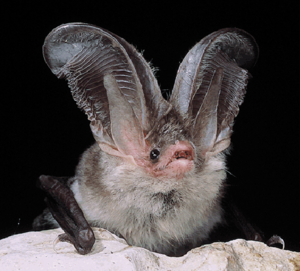Sardinian long-eared bat facts for kids
Quick facts for kids Sardinian long-eared bat |
|
|---|---|
 |
|
| Conservation status | |
| Scientific classification |
The Sardinian long-eared bat (Plecotus sardus) is a very special type of bat. It lives only on the island of Sardinia in Italy. This bat is "critically endangered," which means it is in great danger of disappearing forever.
Discovering the Sardinian Bat
Scientists first found this bat in 2002. They discovered it living in caves in central Sardinia. The very first place they saw it was a cave in Lanaitto's Valley, near a town called Oliena.
Scientists believe this bat is related to other bats, like the brown long-eared bat. They figured out it was a brand new species by studying its DNA. This showed clear differences from other similar bats.
What Does This Bat Look Like?
The Sardinian long-eared bat is quite small. Its head and body are about 45 mm (1.8 in) long. Its ears are very long, about 38 mm (1.5 in)! This bat weighs up to 9 g (0.32 oz), which is about the same as a few paperclips.
- It has a cone-shaped nose.
- There's a small, fleshy bump on its chin.
- Its oval ears are connected above its forehead by a thin skin.
- Inside its ear, there's a pointed part called a tragus. This part helps the bat hear.
- Its wings are attached to its back toes.
- The tail is long and sticks out a little past the skin between its legs.
The bat's fur is soft and woolly. It's greyish-brown on its back and lighter, like whitish or pale brown, on its belly. Its wing membranes are brown.
Why Is This Bat in Danger?
The Sardinian long-eared bat was only identified in 2002. Since then, it has only been found in three caves where it rests during the day. Two of these caves are in the Gennargentu National Park. The third cave is closer to the coast.
This bat hunts for food in forests. It faces several big problems:
- Habitat loss: Its forest homes are shrinking or changing.
- Disturbance: People visiting the caves can disturb the bats.
Because there are so few of these bats, and their numbers are going down, the International Union for Conservation of Nature (a group that tracks endangered animals) has listed it as "critically endangered." This means it's very close to disappearing forever.
The Sardinian long-eared bat is the only native mammal still living on Sardinia. All other unique mammals that once lived there have sadly become extinct since humans arrived about 8,500 years ago. This makes protecting this bat even more important!


